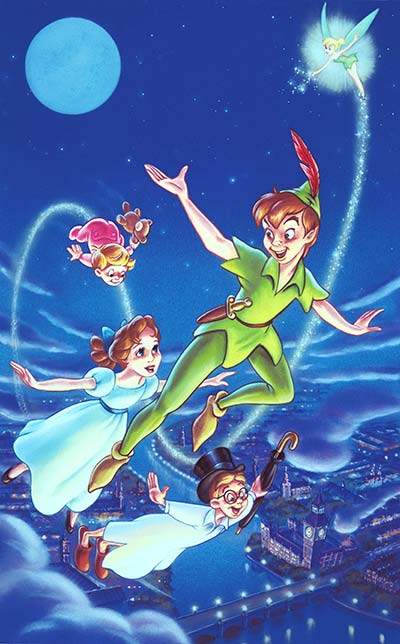
Welcome to Revisiting Disney! Today, we’re looking at a film that flies on its own and may be one of the most beloved Disney films of all time, Peter Pan! I’ve labeled each category, so if you want to skip to the parts that interest you most, feel free. And, of course, if you have any thoughts, burning or otherwise, please share in the comments!
PETER PAN’S BACKGROUND
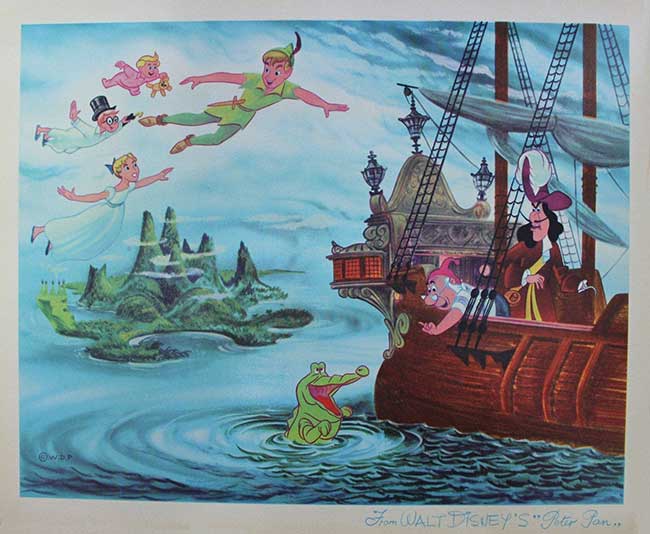
A very successful film, Peter Pan was released on February 5th, 1953, and based on Scottish playwright Sir James Matthew Barrie’s play “Peter and Wendy,” or “Peter Pan,” later adapted into the book, Peter Pan. JM Barrie had left the copyright of his story to the Hospital for Sick Children on Great Ormond Street in London, and Disney acquired the rights to make the film in the late 30s, before the War.
Having seen the play, with Maude Adams in the role of Peter, as a young child, the story held a special place in Walt’s heart. He also played Peter Pan in a school production. Early ideas for the adaptation were darker than the studio wanted, so those ideas were not used as Walt wanted to make sure that his film conveyed the wonder and imagination of the play.
Adrian Bailey says that the story of Peter Pan had a great appeal for Disney, and from listening to the “Making of Features,” this seems to be accurate. There are lots of aspects of the story that translate beautifully to animation in ways that are more challenging to do on stage (at least in the 1950s).
The use of animation as a medium gives us a Tinker Bell who is more than a spot of light, a new way of looking at the story, and a Peter who is portrayed as a boy. There is a longstanding tradition of Peter Pan being portrayed by a woman in the theater, but Disney picked Bobby Driscoll to play Peter. Driscoll was the first male to play Peter Pan in a film (though not the last).
The film does, however, play homage to the play in several ways, casting Hans Conried as both Mr. Darling and Captain Hook and giving the Crocodile some dog-like qualities (as both Mr. Darling/Captain Hook and Nana/the Crocodile are dual roles in the play). Many members of the cast were also radio actors, giving these characters very expressive voices.
My favorite IMDB piece of trivia on Peter Pan is that while Disney thought his Peter was too unlikable and a bit heartless, experts on Barrie praise the Disney Peter, calling the original a “heartless sociopath.” I think that’s a little harsh (just a little, mind you), but we’ll talk about that a bit more in the “Source Material” section.
RELATED: Fall 2015 Box Office Preview
The film appealed to a lot of people, and made up for the disappointing Alice in Wonderland, though some “Barrie loyalists” did not like it, “particularly for its portrayal of Tinker Bell” (Thomas 1997: 102).
MUSIC
In his book, Bob Thomas quotes several animators as remembering Walt emphasizing the music of the film, saying that he thought it would tie the film together (Thomas 1997: 102). While the music did not win any awards, it was brought to us by Oliver Wallace, the brain behind the music in Dumbo, Cinderella and Alice in Wonderland.
This is fun, because it not only gives the early 50s films a sense of musical continuity, it also allowed Wallace to use the musical segments that were cut from Alice. This gave us “The Second Star to the Right” and the Crocodile’s Theme.
The music is catchy. Even through the dialogue, I found myself tapping my toes consistently. These are some songs that have burrowed themselves into our minds. If I say, we’re following the leader, that song is now stuck in your head (you’re welcome). We all know “The Second Star to the Right” and where it leads.
The music for Peter Pan was created specifically for the Disney film and entirely separate from the stage versions. I like this because it sets this apart as a different adaptation in a way that might have been more difficult to convey if the music had been borrowed from the stage productions.
ANIMATION
The Nine Old Men all worked on this film as Directing Animators, along with Norm Ferguson (this would be his last Disney film). As far as the Nine Old Men go, Frank Thomas animated Captain Hook, Marc Davis crafted Tinker Bell and Milt Kahl worked on Peter Pan. The men had several interesting things to say about their work on the film in the “Making Of” features, as well as in Bob Thomas’ book, so I’m going to share some of that here.

Milt Kahl had said that Peter was a challenge to animate because he is a weightless character. As the viewers, we’re not supposed to think about that, but for me, once I heard that comment, I started to notice it and was struck by how amazing it looked. The character does look weightless, in a way that the other characters don’t.
During an interview, Frank Thomas recalled that he had been wondering, in his words, “who was going to get the juicy assignment of animating Captain Hook,” and was surprised to discover it was him. He recalls being confronted with two separate visions of Hook. On one hand, he was a foppish character, who drank champagne and had a Sunday set of hooks and hook accessories; on the other hand, he was a brutal pirate who shoots his own crew, runs out the deck guns to attack a group of children and tries to drown a little girl for information.
Thomas was able to combine both aspects of Hook into his character, and by all accounts Walt had told him to go with his gut. The character ends up being an amazing blend of these two visions (foppish, thirsty and terrified of a crocodile).
Marc Davis talked about the challenges of Tinker Bell because she had been, traditionally, portrayed as a ball of light on stage (just a high-powered flashlight, really). In animation, however, that can’t be done. He was able to come up with the concept and design that we all know and love. He mentioned that he drew her as a pantomime character so that even though she is not speaking, we the audience can tell what she is feeling.

The live-action model for Tinker Bell was Margaret Kerry (who also voiced one of the mermaids), not Marilyn Monroe. The Marilyn Monroe rumor was specifically mentioned during the “Making Of” feature and debunked. Despite the fact that Tinker Bell doesn’t speak except through the bells, some have been unhappy with the design, calling her too curvy and bad-tempered (though I submit that she was pretty bad-tempered in the book as well).
Mary Blair was again involved in color and styling, which gives the backgrounds a bright and surreal quality. With respect to the backgrounds, it looks like Alice in Wonderland. Like with Alice, David Hall did initial work on storyboarding, but it ended up being too dark for a Disney film.
Ollie Johnston remembers that “Peter Pan had good imagination and very good characters, and you could get involved in it,” which seems to be the opposite of the problems faced by the animation team when making Alice (Thomas 1997:102).
The film cost $4 million and had some great technical innovations. Part of the reason the film was in production for so long was Walt’s desire to make it as true to the spirit of the original story as possible, and that involved waiting for and developing new technologies. The team used multiplane cameras to great effect, and Thomas says that the flying scene at the beginning of the film “required twenty levels of paintings” (Thomas 1997: 102).
THE PLOT
If you haven’t read or seen “Peter Pan” in some form or another, you’re missing out and you really should. It’s fairly fantastic. Here’s a brief summary hitting the highlights, just in case.
The film opens up in London, showing us the Darling family and introducing Peter Pan as a character that some of the Darlings believe in. After Nana the nursemaid (and dog) is banished for the night, Wendy casually mentions taking the shadow of a boy away from Nana.
Mrs. Darling is a little concerned about a shadow in the nursery, but her husband laughs it off and says it must have been an illusion because Peter Pan isn’t real. The joke’s on them, however, because Peter is there, listening. He gets into the nursery, finds his shadow and teaches Wendy, John and Michael to fly, after which, they all head to Neverland.

Tinker Bell, Peter’s fairy, is very unhappy with the situation because she hates Wendy, but Peter overrules her. Our first sighting of Neverland introduces us to the pirates, particularly Hook. We learn what Hook’s motivation is; it’s vengeance for his hand being cut off and fed to a hungry crocodile.
The crocodile is constantly popping in and out, trying to eat Hook. Peter and the children arrive at Neverland and Hook tries to shoot them with the cannon (overkill, much?). Peter sends Tinker Bell to bring Wendy and her brothers to the Island, but she tells the Lost Boys that Peter wants them to shoot the Wendy-bird down. Luckily Peter saves Wendy, but Tinker Bell is banished as a result (you can’t try to kill Peter’s friends and get away with it).Wendy, however, is a caring person who convinces Peter to make it a temporary banishment.
Peter and Wendy go to see the mermaids while John, Michael and the Lost Boys go hunting for Indians. The boys are ambushed by the Indians and lose horribly but are surprised to learn that it’s not part of the game they usually play with the Indians. Princess Tiger Lily has been kidnapped and the boys are actually in danger.
Meanwhile, Peter and Wendy run into Hook and the kidnapped Princess Tiger Lily. Peter and Hook fight, and it ends with Hook being chased by the crocodile and Peter saving Tiger Lily. Meanwhile, Hook tricks Tinker Bell into revealing the location of Peter’s hideout. When the Darlings and the Lost Boys decide to go back to London, they are captured by the pirates.
The pirates try to convince them to become pirates and join Hook’s crew, but Wendy convinces the boys to stay strong. Although Wendy thinks Peter will save them, Hook informs her that he has left a bomb to kill his annoying opponent. Luckily, Tinker Bell is able to save Peter, who then saves her. The two of them save Wendy and the boys, take over the ship and fly it to London.
The story ends with the pirates trying to save Hook from the crocodile, Peter and the Lost Boys sailing their flying ship, and Mr. and Mrs. Darling acknowledging the sense of wonder that they had lost when they grew up. Although the Lost Boys decide that they aren’t ready to leave childhood behind and grow up, Wendy realizes that she is.
Peter Pan is really what every kid dreams they can be; he fights pirates, saves his friends, and can fly.
SOURCE MATERIAL
Peter Pan was based on the play of the same name by Scottish playwright Sir JM Barrie, who was born in 1860 and died in 1937. He was knighted in 1913 for his “services to literature” and received honorary degrees from the Universities of Oxford, Cambridge, St. Andrews and Edinburgh.
After 1928, royalties from “Peter Pan” were given to the Great Ormond Street Hospital, and when the normal rights would have expired, Parliament passed a special act allowing the royalties to permanently go to the hospital.
Barrie adopted the five Llewelyn-Davies boys after the death of their parents, his good friends Arthur and Sylvia. The boys; Peter, Jack, George, Michael and Nicholas; and their adventures were the basis for the story of “Peter Pan,” though Michael was supposedly the inspiration for Peter (not his brother Peter). Several of the boys’ lives ended tragically, Michael drowned in 1921, George was killed in action in 1915 and Peter committed suicide in 1960.

The story of “Peter Pan” seems so timeless, I think because it draws on the power of imagination and the importance of childhood. In the book, everyone has their own NeverLand that is designed based on what they imagine a world of adventure to be. When the Darling children arrive there, each of their NeverLands has combined to make the one they are visiting.
There are also fun touches in the story, like the idea that a mind is like a closet and at night mothers go in and pack away the angry thoughts, leaving the nice ones on top. The story also makes Mr. Darling less abrupt than the film and shows what he has sacrificed for his family.
It seems that, since the original story sets up Neverland as a unique place where everyone’s imagination plays a part; the fact that the Disney film is different from the others fits in beautifully. The film fits into the spirit created by Barrie in its celebration of childhood and the acknowledgment that though all children grow up (save one), we don’t have to sacrifice that sense of wonder that makes childhood so wonderful.
RELATED: Web Series Adaptations Exploration
There is a rumor that Peter Pan is an angel of death, and that he takes kids to Neverland (which is a symbolic heaven). While I can see where that comes from (he takes kids that fall out of their prams and they jump out of the window on their way to Neverland) there are other factors that interfere with that theory.
The Disney Peter, you see, is much nicer than the original Peter. The Peter Pan in the book was the only one who didn’t age, and he would kill the Lost Boys when they got too old. When Tinker Bell tells them to kill the Wendy, they don’t question it, because they don’t question Peter’s orders.
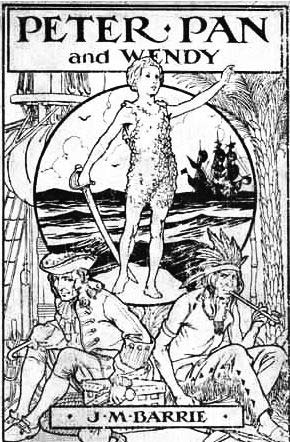
Another thing that stands out is that in the book, Peter says whatever pops into his head, including the way to Neverland, so they are flying for a good chunk of time. As Michael is young, he keeps falling asleep and needing to be saved. Peter finds this hilarious and always waits until the last minute to save him. Peter also tricks Wendy initially into coming with him to Neverland.
In the end, Peter comes back every year to take someone to Neverland for spring cleaning, first Wendy, then her daughter Jane, then her granddaughter Margaret. The book ends by telling us that this will go one “so long as children are gay and innocent and heartless” (Barrie 1998: 272).
The 1950’s-or, Dang It, Disney!
I bet you all see where this is going. Well, this film was released in 1953. When I was a kid, there were things that I wondered about, but got caught up in the catchy beats and didn’t think about it too much (I was eight or so). Watching Peter Pan as an adult, however, gave rise to many feelings of discomfort, particularly when they started talking about the Indians.
The first time they said Injun and savage, I felt pretty uncomfortable, but when they started throwing out the names of actual tribes, I started to squirm a bit. Disney has had moments of insensitivity in other films, (the crows in Dumbo and the cats in Lady and the Tramp come to mind. Check out the Dumbo post for more on that topic), but this was a whole new level to me.
RELATED: Revisiting Disney: Dumbo
In Dumbo, there is the idea of a badly executed homage to famous vaudeville performers. However, unlike in Dumbo, the Disney Company doesn’t even have a response to the accusations of racism in Peter Pan. In Peter Pan, we instead get an entire song called, “What Made the Red Man Red.” This number is introduced when the Chief says, “Teach ‘em paleface brother all about red man,” and answers questions like what makes the red man red (they are portrayed as red), when did he first say ugh, and why does he ask you how?
Why on earth would Disney chose to make characters in such a stereotypical and, frankly, racist, fashion? Was that not considered racist at the time? Though, I think it should have been… This was something that I thought I should look into and see what I could learn about the culture of the 1950s.
I did some digging into films of the 1940s and 50s, particularly the old Westerns (which I dearly love) to see if this was a Disney being racist thing, or a reflection of the culture of the time. I was able to confirm that it was a reflection of the culture of the time, which does not by any stretch of the imagination make it okay.
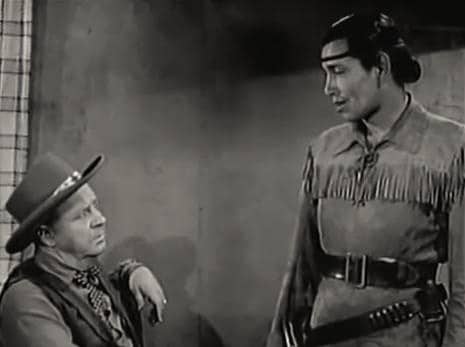
Most of his work was as a Native character, and once he became known for being Tonto, he was typecast. He became an outspoken activist to improve how Native Americans were portrayed in the media and was an acting teacher before his death in 1980. According to his IMDB page, he “despised his show-business portrayal of an Indian” and is quoted as saying about Tonto that “he’s stupid. The Lone Ranger treats him like some kind of servant, and this seems to suit Tonto fine.” Just from this, I can see why improvement was needed in the media portrayal.
Basically, this was nothing new or just left to Disney. The idea of Cowboys and Indians as part of the little boys’ adventure stories that are woven into our culture persist and are based on serious conflicts. These romanticized stories, however, as inaccurate as they are, don’t stop in the 50s but continue on to shows like“F Troop” in the 60s and other Western films.
The history of the American West has been so romanticized over the years as people striking out into the bold new frontier that it’s easy to forget things like Wounded Knee, the Trail of Tears and the forced removal of Native Americans from their ancestral homes.

Plus, I’m going to be honest; the American West was dangerous. You had illness, conflicts, explosions, robberies, outlaws and interracial conflict. Very few shows or movies can portray what life was like on the frontier, because people were also kind of disgusting, it was dusty, there was a lot of hard work involved in day to day life and soap could be scarce (though “Hell on Wheels,” which is about the building of the transcontinental railroads, is pretty good as far as accuracy goes).
Later shows, like “The Young Riders” (1989-1992) and “Dr. Quinn, Medicine Woman” (1993-8), featured Native American characters that seem to be less two-dimensional (for lack of a better word) than the Native American characters in the 40s, 50s, and 60s.
The fact that this scene in Peter Pan is a scene that makes many people squirm today can tell us a bit about how far we’ve come in terms of addressing stereotypes in film. Are we perfect? No, of course not, people can be jerks. But seeing that we have improved, even a little, is positive. And I am a firm believer in not hiding things in the past that make us uncomfortable. We have to be able to address those things that happened if we ever are to move on and create a better tomorrow, together.
Disney (and Barrie) have been criticized for the stereotypical depiction of Natives in this film and in the original play. One suggestion is that Disney wasn’t trying to portray Native Americans, but Native Neverlandians, but as soon as they mentioned actual tribes that theory became less likely.
LESSONS LEARNED
I learned several things from Peter Pan. First, I learned that we all have to grow up sooner or later (all children grow up, save one), but that doesn’t mean that we can’t still have a sense of youthfulness. Mrs. Darling believes in the idea of Peter Pan (as the spirit of youth) and Mr. Darling ends the story remembering his own childhood. This helps him understand and relate better to his own children.
And with that, we all have to grow up. We can’t all be Peter Pan, and that’s okay. Being an adult can be fun (just don’t be an angry one, like Captain Hook). Remember your childhood and use that sense of wonder and whimsy in your day-to-day life. You can be an adult and still have that.
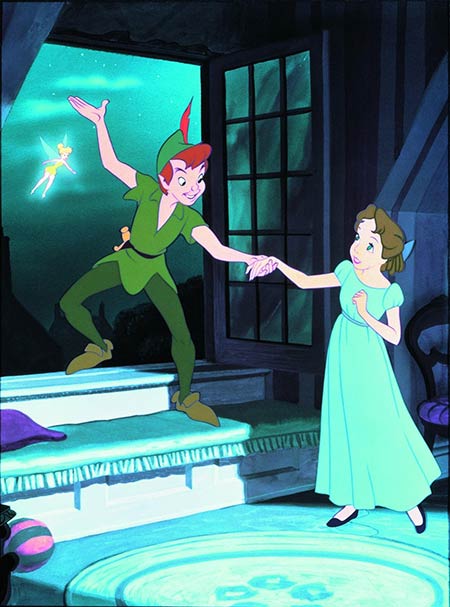
Secondly, I learned the importance of not letting jealousy or revenge consume me. Revenge against Peter leads a truly fearsome pirate to spend his entire life trying to enact revenge on a flying, immortal ten-year-old. His crew threatens mutiny multiple times throughout the story, and he ends the film being ship-less and chased by a crocodile.
The jealous aspect comes from Tinker Bell. She was so jealous of Wendy that she tried to kill her and gave up Peter Pan’s hideout to his sworn enemy to get Wendy out of the picture. In the end, Tinker Bell is able to redeem herself, but it takes her a while (she only has room for one emotion at a time, after all).
These lessons are still applicable today and are part of the reason that we all know the story. Peter Pan is still a part of modern culture, featuring in shows like “Once Upon a Time” and being retold in new ways, while still maintaining the spirit of Barrie’s original work.
RELATED: Thirty New and Upcoming Fairy Tale Retellings in Literature Part 1
DOES IT HOLD UP?
As a kid, Peter Pan was one of my favorite Disney movies, because of the amazing score and the beautiful animation. I also loved the characters and the sense of adventure. It’s one of the classics because it includes pirates, mermaids, and flying. Are there problems in the story and the execution? Oh boy, are there ever, but to ignore the film because of those problems is both ignoring a part of our history and doing a disservice to an otherwise fun movie.
Overall, I still love this movie, though someday when I watch it with my kids I look forward to mentioning all the things that are wrong with it and having that discussion while still preserving the magic and whimsy that is present in the rest of the film. Yes, it’s a complicated answer, but it’s a complicated question.
If we ignore things in our past that are uncomfortable, we are doing a disservice to our future. We need to be able to talk about these things and go, “Wow, 1950s, that was incredibly racist of you. On the bright side, we all know that now and can do our best to prevent something like that from being done again.” Do parts in the film make me very uncomfortable? Yes. Is it still a beautifully animated film about childhood and adventure? Yes. After all, imagination gives you wings.
Photo Credit to Peter Pan (1953) images: Walt Disney
For next week: Lady and the Tramp
If you enjoyed this post and the others in the Revisiting Disney series, and have found yourself wishing that you could find them all in one convenient and bound book with eight extra essays, there is an option for you! Check out A Journey Through Disney: My Look Back Through Disney Canon, now available on Amazon as both a Kindle book ($4.99) and a paperback ($11.99).
OTHER SOURCES:
https://thewaltdisneycompany.com/about-disney/disney-history
http://www.history.com/topics/1950s
http://magicofmaryblair.com/
http://studioservices.go.com/disneystudios/history.html
Bailey, Adrian. Walt Disney’s World of Fantasy. Everest House Publishers. New York, New York. 1982.
Barrie, J.M. Peter Pan. Robert Frederick Ltd. Bath, UK. 1998.
Finch, Christopher. The Art of Walt Disney: From Mickey Mouse to the Magic Kingdom. Harry N. Abrams, Inc. New York, New York. 1975.
Kitch, Carolyn. The Girl on the Magazine Cover: The Origins of Visual Stereotypes in American Mass Media. University of North Caroline Press. Chapel Hill and London. 2001.
Sale, Roger. Fairy Tales and After: From Snow White to E.B. White. Harvard University Press. Cambridge, MA, 1978.
Tatar, Maria. The Annotated Classic Fairy Tales. W.W. Norton and Company. New York and London, 2002.
Thomas, Bob. Disney’s Art of Animation From Mickey Mouse to Hercules. Hyperion. New York, New York. 1992.
Wright, Gordon. The Ordeal of Total War: 1939-1945. Harper Torchbooks, Harper & Row. New York, Hagerstown, San Francisco, and London, 1968.
ARE YOU A ROMANCE FAN? FOLLOW THE SILVER PETTICOAT REVIEW:
 Our romance-themed entertainment site is on a mission to help you find the best period dramas, romance movies, TV shows, and books. Other topics include Jane Austen, Classic Hollywood, TV Couples, Fairy Tales, Romantic Living, Romanticism, and more. We’re damsels not in distress fighting for the all-new optimistic Romantic Revolution. Join us and subscribe. For more information, see our About, Old-Fashioned Romance 101, Modern Romanticism 101, and Romantic Living 101.
Our romance-themed entertainment site is on a mission to help you find the best period dramas, romance movies, TV shows, and books. Other topics include Jane Austen, Classic Hollywood, TV Couples, Fairy Tales, Romantic Living, Romanticism, and more. We’re damsels not in distress fighting for the all-new optimistic Romantic Revolution. Join us and subscribe. For more information, see our About, Old-Fashioned Romance 101, Modern Romanticism 101, and Romantic Living 101.

Comments are closed.